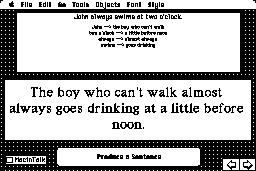Charles I. Kelly
Aichi Institute of Technology (Toyota, Japan)Originally published in
Bulletin of Aichi Institute of Technology
Vol. 28, Part A, pages 51-55
March 1993
2. Next, go to the sentence card (Fig. 2) and input some sentences which your students should know.
 Figure 1. The Sentence Production Card is where the sentence are made. In the top field you can see what
Figure 1. The Sentence Production Card is where the sentence are made. In the top field you can see what
Aichi Institute of Technology (Toyota, Japan)Originally published in
Bulletin of Aichi Institute of Technology
Vol. 28, Part A, pages 51-55
March 1993
Abstract
This is a description and explanation of a random sentence generator which can be used in the study of foreign languages. The paper explains in detail how to use the Hypercard stack Random Sentences. A listing of the stack's script is also included. This random sentence generator differs from others in that the user is allowed to input sentence patterns as regular English and does not need to use "grammar" language or code words.Introduction
This paper describes and explains the random sentence generator, Random Sentences, which I wrote using Hypercard on a Macintosh computer. This random sentence generator differs from others in that the user is allowed to input sentence patterns as regular English and does not need to use "grammar" language or code words. Since the input of data is simple, it is a useful tool for second language learners. A teacher can customize this stack to fit the needs of his students or the student himself can experiment with his own sets of sentence patterns and substitution phrases. The user may alter the data without any knowledge of Hypertalk.Random Sentence Production
When you start this Hypercard stack, it will open up to the title card which includes the title, copyright notice and information about the stack. Click on the Start button and you will be brought to the Sentence Production card (Fig. 1). Click the Produce a Sentence button. On the screen you will first see the sentence pattern which was randomly chosen from the Sentence Pattern card (Fig. 2). Next, you will see the words or phrases to be replaced (wildcards) followed by the words or phrases (substitutions) randomly chosen from their respective cards (Fig. 3) which will replace the wildcards Finally, the finished sentence will be displayed on the screen. If you have chosen the Macintalk option and if you have Macintalk in your system folder, you will hear the sentence spoken by Macintosh's speech synthesizer.Customizing the Stack
Here is a step by step explanation of how to customize this stack for your own students.1. Make a copy of the original stack. Go to the title card of the new stack and click the Make a Blank Stack button.2. Next, go to the sentence card (Fig. 2) and input some sentences which your students should know.
I am John.3. Next, enter the wildcards and the substitutions. Notice that in the above sentences we have three sentences with the word "John". So we may consider "John" to be a wildcard. Go to the substitution card (Fig. 3) and enter "John" in the Wildcard field. In the Substitution field of the same card, enter names of people (George, Jane, Mr. Jones, etc.) and singular phrases for people (a man, an American, a young girl, etc.).Repeat the process with the following information. To make new data cards, choose New Card from the Edit menu.
Are you John?
This is a pen.
These are pens.
John has a pen.
John can swim.
etc.
Wildcard: a pen4. Now go to the Sentence Production card (Fig. 1) and try it out.
Substitutions: an appleetc.
Wildcard: pens
Substitutions: books
my magazines
etc.
Wildcard: swimplay baseball
etc.
Wildcard: can
Substitutions: must
should
Substitution Within Substitutions
It is possible to have the computer substitute into the substitutions already made. For example, if "a pen" is substituted by "a blue book" and if you have a card like the one below, the word "blue" will be substituted by one of the other colors. For this to work, the card "blue" must be after the card "a pen".Wildcard: blue
Substitutions: yellow
red
etc.
More Ideas for Customizing
The most obvious customization is to use sentence patterns and vocabulary that the student already knows. The stack can be expanded by adding new sentence patterns and new phrases as the student learns them. Other possibilities are to limit the patterns while introducing new vocabulary or to limit the vocabulary while introducing new sentence patterns. It is possible to customize stacks using many different teaching approaches (grammar, functional, situational etc.). If the teacher is developing a lesson on survival English for travel, all phrases could be limited to those that might be used when traveling or those that include useful vocabulary for the traveler. For teachers developing a lesson on the use of modals, all sentence patterns should include a modal wildcard (e.g. must) and a card should be included in the stack which has all the modals being studied (e.g. can, should, etc.).The Cards
 Figure 1. The Sentence Production Card is where the sentence are made. In the top field you can see what
Figure 1. The Sentence Production Card is where the sentence are made. In the top field you can see what 
No comments:
Post a Comment